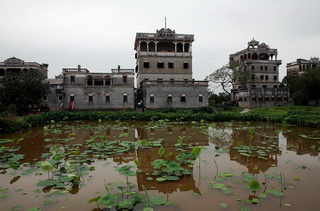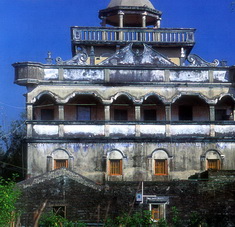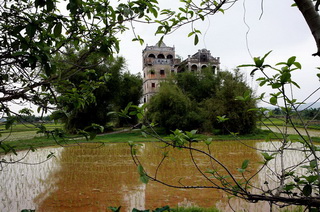 Kaiping Diaolou and Villages, feature the Diaolou, multi-storied defensive village houses in Kaiping, Guangdong Province, which display a complex and flamboyant fusion of Chinese and Western structural and decorative forms.
Kaiping Diaolou and Villages, feature the Diaolou, multi-storied defensive village houses in Kaiping, Guangdong Province, which display a complex and flamboyant fusion of Chinese and Western structural and decorative forms. The earliest preserved villages were constructed in the 14th century, and the diaolous were initially built in the 16th century. Originally, the Diaolou of Kaiping was built to protect the residents against intrusion and forays by local bandits. In the 1920s and 1930s, Kaiping Diaolou reached its peak, with over 3,000 diaolous scattered around the whole Kaiping area. About 1,830 well-preserved diaolous remain.
Kaiping has long been a major hometown for immigrants, many of whom brought the ideas and architectural styles of the West to Kaiping. The diaolous primarily use the Romanesque, Islamic, Baroque and Rococo architectural styles and decorative forms. They were mainly made of reinforced concrete, which was rare in Asia in the 1920s and 1930s. On the exterior, the buildings are typically western; but inside everything, from the frescos to the utensils, are of traditional Chinese style.




The Diaolou of Kaiping is made of stone, compressed earth, bricks or concrete. Despite the distinct differences in building materials, architectural styles and decorative forms, all of the diaolous share some common features. The windows and doors are very narrow and small. Watchtowers on the top floor, with embrasures in the four cardinal directions, provide excellent views of the surrounding area.
Kaiping Diaolou and Villages is also an example of the incorporation of the natural and cultural landscape. In spite of importing the western architectural style, the buildings still maintain a harmonious relationship with the surrounding rural landscape. The unique scene is spectacular.

 China Tours
China Tours Tibet Tours
Tibet Tours China Theme Tours
China Theme Tours Off The Beaten Track
Off The Beaten Track Yangtze Cruises
Yangtze Cruises China Trip Planner
China Trip Planner Travel Agents
Travel Agents China Tours
China Tours Tibet Tours
Tibet Tours China Theme Tours
China Theme Tours Off The Beaten Track
Off The Beaten Track Yangtze Cruises
Yangtze Cruises China Trip Planner
China Trip Planner Travel Agents
Travel Agents


 0086-28-85711328
0086-28-85711328 0086-28-85546015
0086-28-85546015




 Kaiping Diaolou and Villages, feature the Diaolou, multi-storied defensive village houses in Kaiping, Guangdong Province, which display a complex and flamboyant fusion of Chinese and Western structural and decorative forms.
Kaiping Diaolou and Villages, feature the Diaolou, multi-storied defensive village houses in Kaiping, Guangdong Province, which display a complex and flamboyant fusion of Chinese and Western structural and decorative forms. 


